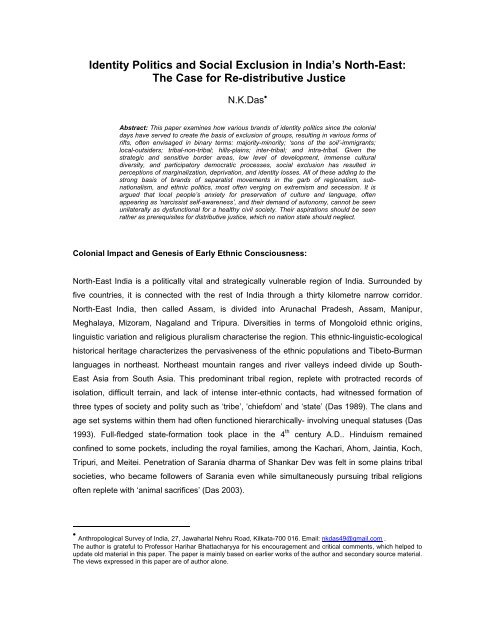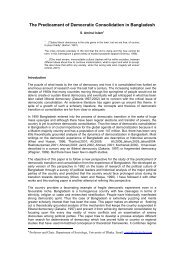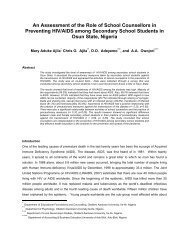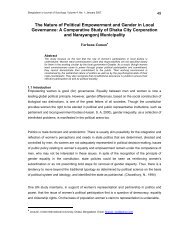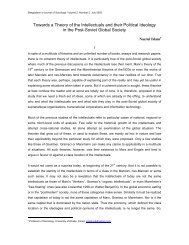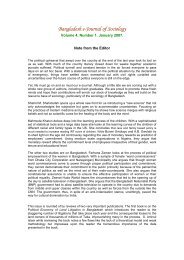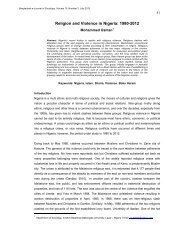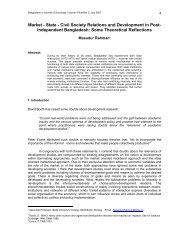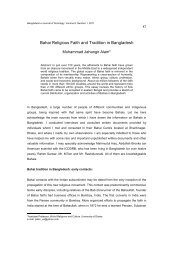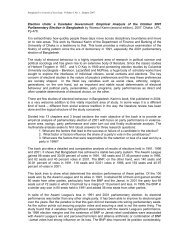N.K.Das - Bangladeshsociology.org
N.K.Das - Bangladeshsociology.org
N.K.Das - Bangladeshsociology.org
Create successful ePaper yourself
Turn your PDF publications into a flip-book with our unique Google optimized e-Paper software.
Identity Politics and Social Exclusion in India’s North-East:The Case for Re-distributive JusticeN.K.<strong>Das</strong> •Abstract: This paper examines how various brands of identity politics since the colonialdays have served to create the basis of exclusion of groups, resulting in various forms ofrifts, often envisaged in binary terms: majority-minority; ‘sons of the soil’-immigrants;local-outsiders; tribal-non-tribal; hills-plains; inter-tribal; and intra-tribal. Given thestrategic and sensitive border areas, low level of development, immense culturaldiversity, and participatory democratic processes, social exclusion has resulted inperceptions of marginalization, deprivation, and identity losses. All of these adding to thestrong basis of brands of separatist movements in the garb of regionalism, subnationalism,and ethnic politics, most often verging on extremism and secession. It isargued that local people’s anxiety for preservation of culture and language, oftenappearing as ‘narcissist self-awareness’, and their demand of autonomy, cannot be seenunilaterally as dysfunctional for a healthy civil society. Their aspirations should be seenrather as prerequisites for distributive justice, which no nation state should neglect.Colonial Impact and Genesis of Early Ethnic Consciousness:North-East India is a politically vital and strategically vulnerable region of India. Surrounded byfive countries, it is connected with the rest of India through a thirty kilometre narrow corridor.North-East India, then called Assam, is divided into Arunachal Pradesh, Assam, Manipur,Meghalaya, Mizoram, Nagaland and Tripura. Diversities in terms of Mongoloid ethnic origins,linguistic variation and religious pluralism characterise the region. This ethnic-linguistic-ecologicalhistorical heritage characterizes the pervasiveness of the ethnic populations and Tibeto-Burmanlanguages in northeast. Northeast mountain ranges and river valleys indeed divide up South-East Asia from South Asia. This predominant tribal region, replete with protracted records ofisolation, difficult terrain, and lack of intense inter-ethnic contacts, had witnessed formation ofthree types of society and polity such as ‘tribe’, ‘chiefdom’ and ‘state’ (<strong>Das</strong> 1989). The clans andage set systems within them had often functioned hierarchically- involving unequal statuses (<strong>Das</strong>1993). Full-fledged state-formation took place in the 4 th century A.D.. Hinduism remainedconfined to some pockets, including the royal families, among the Kachari, Ahom, Jaintia, Koch,Tripuri, and Meitei. Penetration of Sarania dharma of Shankar Dev was felt in some plains tribalsocieties, who became followers of Sarania even while simultaneously pursuing tribal religionsoften replete with ‘animal sacrifices’ (<strong>Das</strong> 2003).• Anthropological Survey of India, 27, Jawaharlal Nehru Road, Kilkata-700 016. Email: nkdas49@gmail.com .The author is grateful to Professor Harihar Bhattacharyya for his encouragement and critical comments, which helped toupdate old material in this paper. The paper is mainly based on earlier works of the author and secondary source material.The views expressed in this paper are of author alone.
Bangladesh e-Journal of Sociology. Volume 6, Number 1, January 2009.2The British colonisation process of Assam started in 1826 and ended in 1898. The colonialregime, at the beginning, resorted to the policy of non-intervention in most of the then largerAssam. Two administrators J.H. Hutton and N.E. Parry advocated for separation of hill areas fromgeneral administrative scheme. In 1873 was introduced “The Inner Line” in hill areas, beyondwhich no person could pass without a license. Local tribes-people resisted colonial interference intheir midst, and thus they often attacked the British. Their resistances were depicted as ‘raids’and ‘uprisings’ (<strong>Das</strong> 1989, 1993:28). There is a long chronology of such resistance. In 1860 and1862 entire Jaintia tribe and the Garos (1852-57, 1872) rose against the imposition of taxes. TheLushai-Kuki, Manipuri and many plains -Assam tribes raided British posts in 1860-90, 1891 and1892 - 1894 respectively. There are records of Aka / Khamti resistances: 1835-1839; Nagaresistances: 1835-1852, and even an agrarian movement in 1893-94.The Sonaram (1902), Kuki(1917) and Jadonang-Gaidinliu movements (Singh,1982; <strong>Das</strong>, 1989) symbolized early ethnicstruggles. Consequent upon the visit of the Statutory Commission in 1920s, further apprehensionof marginalisation, had grown among the tribes’ people and minority communities. Colonial rulersallowed missionary activities. Association with the Christian missionaries and gradual spread ofeducation amongst the tribes and other communities infused a sense of self-esteem. This factoris crucial to understand the birth of ethno-nationalism eventually among the Nagas, Mizos, andthe Manipuris. In some hills and the Brahmaputra valley, there was simultaneous revulsion forAssamese linguistic-cultural domination. This perception alienated a few tribes and thus theregrew discontentment among the Bodos, the Karbis, the Ahoms and many others. Under therelatively peaceful period of 1930s, which may be called ‘the silent phase of identityconsciousness’; the tribes’ people had demanded ‘participative representation’ in the principalLegislative Assembly. The Khasi, Ahom, Naga, Mizo, Bodo-Kachari, Miri and Deuri were the firstto demand “ethnic representation”. Lalungs established a Durbar in 1967, and Koch people hadsimilarly been conscious about their minority status. In a memorandum submitted to AssamGovernment the Assam-Koch-Rajbanshi-Khatriya Sammilani, a combined ethnic group,demanded proper representation in all bodies, quota in employment, scholarships to students andpublication of their history and culture. As a result the All Assam Garo Union was established in1983. The Hajongs in Assam urged the government to recognize them as a scheduled tribe.In the long history of this region the feelings of in-group and out-group, perceived marginalisation,and minority-consciousness have variously surfaced as key factors causing ethnic unrest.Depending on varied influences of marginality and ethnicity some movements remained moreexplicit and specific than others, in articulating and defining their objectives. These movement’sstrategies of operation correspondingly varied. Ethnic conflicts in northeast originally grewessentially through primordial affiliations. The distinctive ethnicity factor amongst communities led
Bangladesh e-Journal of Sociology. Volume 6, Number 1, January 2009.3to steady expansion of aggressive binary categories of in-group and out-group (<strong>Das</strong> 1989, 1994,2004, 2007).Linguistic and Religious Revivalist Movements:Language has always been in the centre-stage of ethnic turmoil in the northeast. MakingAssamese as the compulsory language from class VIII onwards led to massive agitation in theBarak valley, reminiscent of the agitation launched earlier over the issue of the medium ofinstruction. In 1972 the Bodo led plains tribes council of Assam (PTCA) complained that the tribesof plains have been “uprooted in a systematic and planned way from their own soil” and that the“step motherly” treatment of the administration, dominated by the Assamese-speaking people hasreduced them as “second class citizens” of the state. The Bodo Sahitya Sabha (established in1952) and PTCA however, ultimately succeeded in making the Bodo language the medium ofinstruction (up to the secondary level). In doing so, the Bodo-leaders opted for the Roman script -though they were ultimately convinced to accept the Devanagari script. The Mishing AgomKebang (Mishing Sahitya Sabha) formed in 1972 and several other Mishing <strong>org</strong>anizations hadalso worked consistently and succeeded in 1987 to introduce Mishing language as a subject ofstudy in primary schools. The rejection of the Assamese script by the Miris, the Bodos and othersdismayed the Assamese, who thought, without their tribal counterparts they may becomeminority, overwhelmed by the Bengali-speaking population (Miri 1993: 71). Following therecognition of native languages at primary level in Bodo-Kachari and the Karbi areas, the Mishingperception of marginalisation sharpened. This led to the formation of Mishing Literary Associationin 1972. In order to maintain a distinct minority linguistic identity vis-à-vis the majority Assamese,the Mishing were in favour of the Roman script. The Assam Sahitya Sabha insisted that theAssamese script should be retained for ‘Mishing language’. The Mishings were ultimatelyfacilitated to use Roman script. Their text books came to be printed in the Roman script and alsosome newspapers and journals. The Bishnupriya Manipuri language issue, particularly in Assam,has also acquired the shape of an ethnic movement.The Ahom, Meitei, Zeliangrong, Seng Khasi, and Zomi communities had all felt threatened by thenear extinction of their original language and religion (<strong>Das</strong> and Gupta 1982; <strong>Das</strong> 1989). InManipur valley the Meitei revivalist leaders (before the formal inclusion of Manipur-Meitei in theEighth schedule to the Constitution), had demanded that the Manipuri language be named“Meeteilon’. The Zeliangrong movement grew as a religious-cultural movement, originally againstthe spread of Christianity, but it assumed as an anti – colonial political overtone. It actually cameout to be the only tribal movement of northeast which maintained links with the national freedomstruggle (<strong>Das</strong> 1989). The Zeliangrong People’s Conference (ZPC), demanded the recognition of
Bangladesh e-Journal of Sociology. Volume 6, Number 1, January 2009.4ethnic nomenclature ‘Zeliangrong’, an acronym ( Ze-Liang- - Rong), who are spread in contiguousareas of Manipur, Nagaland and Assam. In our report submitted to the government through theDirector General of the anthropological survey of India, we had suggested recognition ofcommon nomenclature as ethnographic facts supported the claims. It was recommended that aninter-state autonomous regional council for the Zeliangrong areas will be best suited to protect thecultural and economic interests of these tribes. In 1905, when the spread of the Christianity waswidely felt in Meghalaya, the Seng Khasi <strong>org</strong>anization took upon itself the responsibility ofdefending the Khasi religion .The members of the association called themselves the ‘Khasi-Khasis’ in order to distinguish themselves from those ‘Khasis’ who had adopted Christianity.Having initiated the process of revivalism and reformation of the Khasi religion, the Seng Khasiencouraged the people to abide by the matrilineal system of descent, to respect the kith and kinon the maternal and paternal side, to believe in God, and to serve God through service ofhumankind. The Seng Khasi flag came to depict a crowing cock in white and red setting. The redsignifies courage and white represents the world. The Seng Khasi started <strong>org</strong>anizing archerycompositions and traditional dance performances such as ‘Ka Shad Suk Mynsiem’ and ‘theNongkrem Dance’.Ethnic Conflict and Militancy:On the eve of independence of India, several ethnic groups had variously made effective use ofthe factors of ethnicity and regionalism as basis of ethnic rage, and democratic struggle for selfrule,greater autonomy and militant actions. Other factors such as frontier location, developmentprocess, rise of Christianity and democratic process, partition of country, influx of ‘infiltrators’ andminority syndrome variously led to claims of separatism among the communities. The moreassertive tribes who consistently rebelled against their incorporation within the new Indian nationstatesuch as the Nagas and Mizos ultimately succeeded in attaining status of ‘statehood’ andgreater autonomy. Thereby, they also succeeded in changing their minority status to that of amajority status in respective hilly states. Even after the formation of Nagaland, however, the Nagamovement had not died, as A.Z Phizo, who had originally given the call for a ‘ long Naga struggle’in 1953, continued to occupy centre-stage later also (<strong>Das</strong> 1982, 1994, 2004, 2007). The Nagamovement, in which both ‘ethnicity’ and ‘extreme nationalism’ were used as operationalstrategies, is regarded as the mother of all movements in northeast India. The origin of ethnicityamong the Nagas may be traced first in the formation of a Naga Club in 1918, which consisted ofthe Naga headmen and members of English educated Naga middle class (<strong>Das</strong> 1982). The Nagasformed the Naga Hills District Tribal Council in 1945, which was renamed as Naga NationalCouncil in 1946 (<strong>Das</strong>1993: 33). NNC had gradually articulated the sense of “Naga nationalism”
Bangladesh e-Journal of Sociology. Volume 6, Number 1, January 2009.5(<strong>Das</strong>1982, 2001). It also emphasised the theme of Naga oneness as ‘a moral category’ (Imchen1993), NSCN (IM) led the Naga movement in its modern phase. In order to globalise the Nagacause, NSCN (IM) took a delegation to the UN Conference of ‘Indigenous Peoples’, held in July1994. Muivah established links with the Asia Indigenous People’s Pact and the Belgium-basedFlemish Support for Indigenous People. The Nagaland Assembly also passed a resolution in1994, extending support to the demand of the greater Nagaland - Nagalim. Outside the hills, theAhoms (who formed the Ahom League, in the wake of 1935 Act) and the Bodos (by formingPTCA) had consistently raised the questions of ‘tribal self-rule’ right from the colonial era. The AllAssam Ahom Association (formed originally in 1893) was perhaps the earliest ethnic associationof its kind (<strong>Das</strong> 2001). From the 1980’s onwards, virtually the entire northeast was plagued byvarious ethnic movements. Most of the movements were non-violent in earlier stages, butgradually assumed severe militant nature. In the seven states of the North-East India reportedlymore than 30 ‘insurgent’ groups operated, carrying on protracted armed-struggle. Among themthe National Socialist Council of Nagaland (NSCN -IM, NSCN-K) and the United Liberation Frontof Asom (ULFA) remained prominent ones. Even though some scholars have tried to applytypology of class-formation to describe the ethnic conflict in the region, it may be argued thatthere are innumerable ethnic – regional factors buttressed by typical tribal features, which seemto influence the escalation of unrest.The following list provides names of the outfits, some of which are no more active, as they usedto be.Arunachal Pradesh:Rabha National Security Force (RNSF)United Liberation Volunteers of Arunachal Koch-Rajbongshi Liberation Organisation (KRLO)Pradesh (ULVA),United People’s Volunteers of Arunachal Pradesh(UPVA),Hmar People's Convention- Democracy (HPC-D)Karbi People's Front (KPF)Barak Valley Youth Liberation Front (BVYLF)United Liberation Movement of Arunachal Birsa Commando Force,Pradesh (ULMA).National Liberation Front of Arunachal: Koj TaraDragon Force (ADF).Adivasi United Liberation Front of AssamCobra Force.United Liberation Front of Barak ValleyMuslim United Liberation Front of AssamAssam:United Liberation Front of Asom (ULFA).Bodo Security Force (BDSF),National Democratic Front of Bodoland (NDFB),(MULFA),Muslim Liberation Tigers of Assam (MULTA),United Social Reform Army Of Assam (USRAA),United People's Democratic Solidarity (UPDS)Dimasa National Security Force (DNSF)Bodo Liberation Tiger Force (BLTF)Dima Halim Daogah (DHD)Karbi National Volunteers (KNV)Manipur:National Socialist Council of Nagaland (NSCN-IM.)
Bangladesh e-Journal of Sociology. Volume 6, Number 1, January 2009.6People’s Liberation Army (PLA)Revolutionary People’s Front (RPF)United National Liberation Front (UNLF)People’s Revolutionary Party of Kangleilpak(PREPAK)Kuki National Organisation (KNO),Kuki National Front (KNF), Kuki National Army(KNA),Kuki Revolutionary Army (KRA) Kuki DefenseForce (KDF)Kuki Front Council (KFC). Manipur People'sLiberation Front (MPLF)People's Republican Army (PRA)Kangleipak Communist Party (KCP)Kanglei Yawol Kanna Lup (KYKL)Manipur Liberation Tiger Army (MLTA)Iripak Kanba Lup (IKL)Kangleipak Kanba Kanglup (KKK)North East Minority Front (NEMF)Mizoram :Hmar People's Convention (HPC)Hmar People's Convention- Democracy (HPC-D)Hmar Revolutionary Front (HRF)Zomi Revolutionary Army (ZRA)Zomi Revolutionary Volunteers (ZRV)Indigenous People's RevolutionaryAlliance(IRPA)Kom Rem People's Convention (KRPC)Chin Kuki Revolutionary Front (CKRF)Bru National Liberation Front,Bru National Front (BNFM) of Mizoram,Bru Welfare Association of Mizoram (BWAM)Nagaland:National Socialist Council of Nagaland (Isak-Muivah) - NSCN(IM) ,National Socialist Council of Nagaland(Khaplang) - NSCN (K)Naga National Council-NNC (Adino), NagaFederal Government (NFG). Naga NationalCouncil (Khodao) – NNC (K).Tripura:TRIPURA: National Liberation Front of Tripura(NLFT), All Tripura Tigers Force (ATTF),Bru National Liberation Front (BNLF).National Liberation Front of Tripura (NLFT):Biswamohan Debbarma,Nayanbashi JamatiaAll Tripura Tiger Force (ATTF): Ranjit DebbarmaTripura Tribal Volunteer Force (TTVF)Tripura Liberation Force (TLF)All Tripura Volunteer Force (ATVF)Tripura National Army (TNA)Borok National Council of Tripura (BNCT)West Bengal:Kamtapuri Liberation Organisation (KLO)Meghalaya:Hynniewtrep Volunteer Council (HVC),Hynniewtrep Achik Liberation Council (HALCHynniewtrep National Liberation Council (HNLC)Achick Liberation Matgrik Army (ALMA),A’chik National Volunteers Council (ANVC).People's Liberation Front of Meghalaya (PLF-M)Hajong United Liberation Army (HULA)
Bangladesh e-Journal of Sociology. Volume 6, Number 1, January 2009.8There is a long history of incursion of outsiders, emigration and resettlement in Assam. One can see thisbroadly in four spheres; tea plantation related manual labour, Bengali Muslim emigration (mostlyoccupying agriculture), Hindu Bengali migration (mostly occupying service sector), and Marwari migrationin trading sector. Bangladesh war resulted in over 10, 00,000 ‘refugees’ taking shelter, who neverreturned. Modern Bangladeshi “infiltration” is however, said to be a more severe phenomenon. It wasalleged that Bangladesh Char area dialects spoken by the migrant Muslims, were declared as Assamesedialect to the census enumerators. Politicians too encouraged the Bangladeshi Muslims and otherminorities into Assam, giving voting rights. This was a narrow exercise in electoral politics (Dixit 1998,2003). This last wave of illegal-exodus from Bangladesh is a more dangerous phenomenon, as someamong these infiltrators are said to have gotten involved in terrorist activities in parts of urban India. It issaid that fear within the native Assamese community of being overwhelmed by the unabated influx ofillegal Bangladeshi migrants from across the porous border triggered off the long-drawn “Anti-Foreignermass uprising 1979 - 1985”, spearheaded by the All Assam Students’ Union (AASU). It ended by arrivingat an agreement, Assam Accord, 15 August 1985. The Accord fixed 25 March 1971 as the cut-off date fordetection and expulsion of the illegal foreign migrants. The Assam movement was led by AASU. AllAssam Gana Sangram Parishad (AAGSP), which was an umbrella <strong>org</strong>anization of several outfits,including Asom Sahitya Sabha, emerged as the political forum the AASU. In 1985, AAGSP swept theelections on the wave of anti-foreigner sentiments. The ULFA’a inception dates back to the frenzied yearsof the Assam Movement when a section of the militant youth lost faith in peaceful programmes of AASUand the AAGSP. According to Baruah (1992) ULFA combined Naxalism, with a strong dose of “subnationalism”.In 1990, the ULFA had f<strong>org</strong>ed links with various insurgent outfits inside and outside thecountry, including the PLA, NSCN and even JKLF in Kashmir. In 1986, ULFA first established contactswith the then unified National Socialist Council of Nagaland (NSCN) and the Kachin Independence Army(KIA) of Myanmar for training and arms. Subsequently, links were established with Pakistan’s InterServices Intelligence (ISI). The ULFA, according to Gohain, advocated a line of “de-nationalization” or“divesting oneself of ethnic identities except that of Assamese identity”. It characterized India as a“colonial state” and the northeast as the ‘colony’, though no serious economic analysis substantiating thisassertion had come to light’.Identity Politics of ‘Small Ethnicities’ and ‘Minority Syndrome’ in Assam:After its partitions, Assam was left with 23 tribes, comprising of 14 hill tribes of Karbi Anglong and NorthCachar Hills; and nine plains tribes inhabiting in the plains of the Brahmaputra Valley. Observingdevelopment in the hills, some tribes became conscious to develop their sub-regions. Some tribes who
Bangladesh e-Journal of Sociology. Volume 6, Number 1, January 2009.9had earlier launched movements rushed to renew their agitations. Thus, the Ahom renewed the demandfor the re- scheduling their scheduled tribe status. In order to push forward demand of a separate AhomState, the ‘Tai-Ahom Land Committee” was formed, by merging old <strong>org</strong>anisations. In 1995 the Ahomsplaced a 17-point charter of demands. Showing his concern for the Ahoms , the then Ahom Chief Ministerof Assam, Hiteshwar Saikia, highlighted the unique cultural heritage of the Ahom people. The Karbis,have been conscious about their minority status vis-à-vis the majority - Assamese. Notwithstanding thegradual incorporation of the Karbis into the Assamese society, culturally and linguistically, the culturalincorporation was never conceded. What is more the kinship based tribal political system, territorialaffiliation (Mikir hills), survival of Karbi folksongs and fable of their distinct origin, tribal mortuary rituals,and tribal costumes which survive in vibrant manner helped the Karbis to put forward their autonomydemand (<strong>Das</strong> 1989:188-90). Though the Karbi National Council demanded in 1986 only an autonomousdistrict, but last two decades have seen the growth of the Karbi Students Association and theAutonomous State Demand Committee (ASDC) spearheading a movement for creation of a separateKarbi state. Seeing ever growing demands of the minority tribes the administration had granted the SixthSchedule status to some plains tribes, such as the Mising, Rabha and Tiwa.The Bodo movement is the longest social movement in the plains of Assam. The first two phases of theBodo movement were concerned with social reforms (1947 – 1967) and consolidation of the Bodo identityvis-à-vis the Assamese community (1967 – 1987). Earlier phase of the Brahma movement (1907onwards) was a short-lived ‘Sanskritization movement’ led by the Mech-Bodos. The early culturalawakenings had led to birth of the Bodo Sahitya Sabha in 1952, which demanded Bodo language as themedium of instruction at secondary level. In its modern phase (1967 onwards) a new section of Bodo eliteemerged which demanded a greater share in political power. A call was given for carving a separateregion called Udayachal. After second phase of mass protests, there was a Bodo Accord signed inFebruary 1993 that had led to the creation of a Bodoland Autonomous Council (BAC). The BAC was anon-starter, as the territorial boundary issue remained unresolved. The movement for maximumautonomy by the Bodos, succeeded ultimately in securing a new politico-administrative structure withinthe existing State of Assam following a memorandum of understanding with the Government of India on10 February, 2003. The Bodo-majority areas have now come under the new Bodoland Territorial Council(BTC), an elective body. The BTC Accord is seen as a fulfilment of the sub-national aspirations of theBodos of Assam. Under the BTC understanding, the Government of India provides financial assistance ofRs. 100 crores per annum for 5 years for projects to develop the socio-economic infrastructure.The North East Indigenous and Tribal Peoples Forum, comprising of fifteen diverse tribal <strong>org</strong>anisations inits meeting in October 1994 resolved that, “The entire region has been swamped by alien peoplemigrating from neighbouring countries and also from other parts of India”(The Telegraph, 6 October,1994). Similarly Tribal Students Federation (TSF) was constituted by several tribal students’ <strong>org</strong>anisationssuch as Karabi Students Union, All Tiwa Students Union ,Takam Miashing Porin Kebang, All Assam
Bangladesh e-Journal of Sociology. Volume 6, Number 1, January 2009.10Deuri Students Union, Maan-Tai Students Union, Sonwal Kachaari Students Union Dimasa StudentsFederation, and All Assam Tribal Students Union. The main objective of the TSF was to provide coherentdirection to the various tribal movements of the region for “the right of self-determination”. An importantaspect of TSF was its abhorrence to militant –armed actions. TSF failed to achieve its goals.In view of extensive demand of Chakma and Hajong for Indian citizenship, the Arunachal PradeshLegislative Assembly passed a unanimous resolution to deport these émigrés settled in the state. Toprotect the cultures of indigenous tribes the Legislative Assembly passed the Bill called “The AarunachalPradesh Protection of Customary Laws and Socials Practices Bill, 1994” for protection of the native tribalinstitutions. The All Arunachal Pradesh Students Union (AAPSU) also opposed such demands ofcitizenship. The Nepalese of Assamese origin demanded 'special protected status’ under the constitution.They aimed to thwart attempts at branding them as ‘foreigners’/illegal infiltrators. Fact remains that theNepalese did face the Khasi anger manifested in the ‘ethnic cleansing’ of the sort in late 1980s, andwhich had triggered the larger Nepalese demand of the Gorkhaland (<strong>Das</strong> 1989, The Statesman, 18 July2002). In September 1994 the North-East-Students-Organization (NESO) alleged that the IllegalMigrants (Determination of Tribunal) Act, 1993, was full of loopholes and which had made detection andexpulsion of illegal migrants in North East difficult. There have been strong reactions to threat ofinfiltration of outsiders in varied manners. Thus, the National Socialist Council of Nagalim (Isak-Muivah)made it mandatory for non- Nagas living “all over Nagalim” to make identity cards for themselves and theirfamilies.In Assam, the Adivasis today can broadly be divided into two communities, the tea garden workers andthose who came out of the tea gardens at the end of their contracts and settled in and around the teagardens after procuring some land. Through gradual expansion these Adivasis, form nearly 20 per centof the state population, but their representation in the legislative assembly is said to be markedly lesser(Other Backward Class, 5 May 2008, India Together News Service). Hiren Gohain has discussed theAdivasi Militancy in Assam. The All Assam Adivasi Students’ Association along with Assam Tea TribalStudents’ Association (strong in Sibsagar, Dibrugarh and Laximpur districts of upper Assam) have beenagitating for years demanding recognition of tea tribals and Adivasis as scheduled tribes. The Adivasishave been neglected by the state. Only special measures, like the campaign against poverty, can wintheir hearts. The state Congress leaders failed to muster political will to fulfil that demand. The latestresponse from the Registrar General is that some relatively homogeneous groups among this populationmay be considered for inclusion under this list if the state government agrees. (Gohain, 2007, Economicand Political Weekly, December 8, 2007).Reconciliation for Self-Rule and Autonomy:
Bangladesh e-Journal of Sociology. Volume 6, Number 1, January 2009.11Cease Fire and Peace AccordsNoteworthy peace initiatives were undertaken during the 1960s and 1970s involving several militantoutfits of the region. However, it was during 1994 that several underground <strong>org</strong>anisations came ‘overground’and surrendered before the government authorities, particularly in Assam, Meghalaya andMizoram. These <strong>org</strong>anisations were the Dimasa National Security Force (DNSF), Achik Liberation MatgrikArmy (ALMA) and Hmar People’s Convention (HPC). The Dimasa Kachari generally live in North CacharHills, Cachar, Karbi-Anglong, Nowgong (all in Assam ) and Dhansiri region of Nagaland. Prior to 1961Census they were identified as a ‘Sub-tribe’ of Kachari. In the 1971 census and afterwards they projectedthemselves as a distinct tribe. The ‘Dimasa Jalairaoni Hosoma’ was established in 1972 to promote theirdistinct cultural identity. The Dimasa National Organisation (DNO) was born in 1979. In March 1979 theDimasa demanded the proper preservation of ancient Dimasa monuments and relics. In 1980, NikhilHidimba Barman Samity, Cachar, demanded re<strong>org</strong>anization of the Dimasa speaking areas of NortheastIndia. Even though the Dimasa National Security Force (DNSP) had close ties with the NSCN its leadersrealized the futility of their actions and thus they had surrendered before the Assam State governmentauthorities in 1994. A breakthrough achieved during 1994 was the signing of the Hmar Peace Pact. Anaccord was signed at Aizal on 27 July 1994 between the Hmar People’s Convention (HPC) and theMizoram government, bringing an end to seven years old Hmar insurgency. The accord envisaged thesetting up of a Hill Development ouncil in Hmar inhabited north Mizoram. In Meghalaya also the AchikLiberation Magrik Army (ALMA), trained by the NSCN, and inspired by the ULFA, surrendered before theMeghalaya Chief Minister at Tura, on 25 October 1994. The Garo Baptist Convention (GBP) played amajor rule in bringing the militants to the negotiating table. In Assam, Hiteswar Saikia (Congress) ledgovernment declared “grant of total autonomy to several major ethnic tribes”. Besides the Bodo Accord(1993), his government signed accords with the Karbi and Dimasa tribals. Self ruling bodies wereprovided to Rabhas, Mishings and Lalung (Tiwas). In Assam, many <strong>org</strong>anizations have ceasefireagreements with the government: U.P.D.S. since January 1, 2004, the U.P.D.S. since May 23, 2002 andthe N.D.F.B. since May 25, 2005. Similarly, in the state of Meghalaya, the Achik National VolunteerCouncil has had a ceasefire agreement with the government since July 23, 2004. U.L.F.A. in Assam in2005, too, has appointed a People's Consultative Group to prepare the groundwork for eventual dialoguewith the government.The Naga peace initiative has a long tradition. Diverse perceptions surrounded the earlier 19-pointAgreement of 1960 and the Shillong Accord of 1975. In recent times the Naga Hoho convened a series ofmeetings of Church leaders and NGOs from all Naga areas culminating in a call for “journey ofconscience” to seek reconciliation and to rebuild the Naga society. A Declaration was adopted in 2001 topursue the cause of peace. Since 1998-99 peace parleys, particularly with the NSCN (IM) has been
Bangladesh e-Journal of Sociology. Volume 6, Number 1, January 2009.12generally successful. The NSCN (IM) has been demanding a homeland for all Nagas living in North East,which will be called ‘Nagalim’. These peace initiatives have led to what is termed as bilateral cease-fire;whereby, belligerence and hostility is halted. Even during cease-fire the cause for worry has been thefratricidal schisms between the different factions of the Naga National Council, the Isak-Muivah group andKhaplang faction of the National Socialist Council of Nagaland. There has been success of peace talkswith the Khaplang faction as well. It is also pleasing that ‘substantive issues’ have been discussed. At thesame time in a statement titled “Journey for Peace” the NSCN (I-M) has recognized the ‘legitimateaspirations of all neighbouring people including the Meiteis, the Assamese and others’ and appealed tothem to ‘let us end tension between us’ (Navalakha 2003). NSCN (I-M) has appreciated the governmentof India’s understanding of the “unique history of the Naga people”. The Kamtapur movement, initiated bythe Kamtapur People’s Party (KPP), involves the Koch and Rajbanshi communities, who call themselvesKamtapuris. The Kamtapuri ethnicity and language question gave birth to this movement, which startedas a peaceful movement, but turned violent after the movement came in contact of the some Assambased militant outfits such as ULFA in 1999-2000.Apart from the demand for a separate state to becarved out from five north Bengal districts, the Eleven - point charter of the KPP includes the recognitionof the Kamtapuri language, introduction of Kamtapuri programmes in TV., and ‘re-settlement’ of thepeople who arrived after 1971.The KPP supporters, mostly of Rajbanshi origin consider themselvesindigenous to the region and they feel they have the right to self-determination. Today indeed thesituations mainly in Manipur, Assam and Tripura remain disturbing. The Manipuri militants have shown noinclination for peace talks. All Tripura Tiger Force and the National Liberation Front of Tripura, whichoperate from camps in Bangladesh, will be weakened by the Naga peace accord, if reached (TheStatesman 23 November 2002). The NLFT has link with the NSCN and the ATTF has links with theULFA. Though the NLFT talks of secession, the state is not their enemy. Their targets are the settlerswho have migrated from former East Pakistan after partition and subsequent settlers who have reducedthe indigenous tribes of Tripura into minority (K. Chakraborty, The Statesman 23 November 2002).A RecapitulationIn North-East India cultural differences and incongruity sharpened the ethnic boundaries and generatedcleavages along ethnic conceit, leading to inter-ethnic discord. Ethnic unrest in northeast is as old as thecountry’s independence. The Indian independence along with the partition, influx of émigrés, suspectedfear of linguistic–cultural subjugation, economic negligence, and failure to value approaching politicalinstitutions variously infused in the minds of the ethnic communities a ‘sense of narcissistic selfawareness’.The spectre of social exclusion, minority-syndrome and ethnic rivalry remained the drivingforce for protests demanding autonomy in the shape of homeland/state/ or autonomous district council,within constitutional framework. Some of the movements followed the violent paths. While the former
Bangladesh e-Journal of Sociology. Volume 6, Number 1, January 2009.13opted for constitutional path, the later sought an extra-constitutional / secessionist ideational path. Everincreasing evidences, however, now indicate that most of the militant outfits in North-East have nowtransformed themselves into terrorist entities, empty of their original objectives and ideology. Forexample, U.L.F.A. in Assam, since 1990s, has repudiated its earlier anti-Bangladeshi position. Vestedinterest and quarrel over interests led militant groups to clash among themselves. It will be incorrect toattach terrorist label to N.S.C.N., but the media reports suggest that most fatalities in Nagaland are theresult of the infighting between the two factions of the N.S.C.N., rather than from government forces.Despite several successful peace initiatives, the security force operations are in place by utilizing thearmy, state police forces and the paramilitary forces to contain militancy.Poor governance has been a major problem in the region. Wasbir Hussain says, ‘the region is caught ina vicious cycle of lack of economic development and then militancy and the resultant violence furtherretard economic growth’. Under this circumstances, it is natural to find the people of the region harbouringa sense of alienation from the Indian mainstream and feel neglected. We have noted above how the stateof Assam is under siege with the aspirations of different communities and groups showing no signs of adecline despite attempts at devolution of power to the grassroots level. B. P. Routray of the Institute forConflict Management, has rightly observed that 'this is primarily a governance issue. Poor governance isthe main trigger factor for ethnic groups clamouring for autonomy. Such demands from newer groups arehere to stay.’ Special provisions for self-governance and autonomy are provided for people of North-Eastwithin the Constitution of India, particularly through such Acts as the Sixth Schedule, NEC andDepartment of North Eastern Region (DONER). The DONER and the North-Eastern Council, under thecentral control need more effectively to tackle the problems of unemployment, underemployment, andeconomic backwardness of the region. Let the people’s representatives monitor the activities of theseinstitutions. The DONER has an annual budget of Rs.550 crores. The NEC has another Rs.500 croresearmarked for the region. These are apart from the enormous amount of funding available to the Statesthrough different central schemes, one-time packages announced by successive Prime Ministers, ‘PeacePackages’ provided to States like Nagaland and Mizoram, grants by international development agencieslike the World Bank, and the Asian Development Bank (ADB), which in 2003 approved a master project ofRs. 2,000 crores for the northeast. These institutional arrangements and provisions need to beappropriately regulated to assuage ethnic misgivings. In more recent years the peace initiatives, such asthe bilateral cease- fires, and the peace talks held between militant leaders and governmentrepresentatives, symbolize the determination of the Nation-state to resort to a broad-spectrum consensuson vital issues by adhering to flexibility and extendibility. These are basic foundations aimed at thenational- consolidation, which should be strengthened. Peace, development and proper linkages arebound together and are intrinsic to harmony in the region. Gradually the region has increasinglywitnessed not only naturalisation of electoral politics, but also slow adaptation of national political parties.
Bangladesh e-Journal of Sociology. Volume 6, Number 1, January 2009.14Resurgence of ethnic identity and persistence of ethicised politics does not indicate repudiation of thepolitical state. Their concern for variously perceived threats to their distinct ethnic identities and theiranxiety for preservation of culture and language and their demand of autonomy can not be seen asdysfunctional for a healthy civil society. Their aspirations should be seen rather as prerequisites fordistributive justice, to which no nation state can neglect. Indian path of institutional adjustments aimed atwining over and changing the opinion of hostile ethnic groups and extending special safeguards to hillStates have helped solve ethnic problems to a great extent. These need to be endured.ReferencesAhmed, A and Shore,C. 1995. “Introduction: Is Anthropology Relevant to the Contemporary World”. In A.Ahmed andC.Shore (eds.), The Future of Anthropolog: Its Relevance to Contemporary World. London: Athlone.Banks, Marcus. 1969. “Ethnicity: Anthropological Construction”. London: Routlege.Banerje, Sumanta. 2003. “Bengali Left”. Economic and Political Weekly. February 22,2003.Bareh, H. 1993. “India’s Northeast and her Ethnic Character During the British and Contemporary Set Up”. In B. Pakem(ed) Regionalism in India. New Delhi: Har-Anand Publications: 196-226Barth, F. 1994. “Enduring and emerging issue in the analysis of ethnicity”. In H.Vermuelen and C.Govers (eds), Theanthropology of ethnicity. Amsterdam: Het Spinhuis.Baruah, A.K. 1993. “A Note on the Impact of Regionalism on a Parliamentary Democracy in India”. In B. Pakem(ed), Regionalism in India. New Delhi: Har-Anand publications: 60-66Baruah, Sanjib. 1992. “Symbolism and Statesmanship”. The Telegraph. June 11, 1992.Bhadra, Gautam.1975. ”The Kuki(?)Uprising:Its Causes and Nature” Man in India 55,1.January-March,1975.Bhattacharya, N.N. 2000. “Trends of Population Growth in North East Region” In B.B. Datta-Ray; H.K.Mazhari;P.M.Passah; and MC Pandey (eds), “New Population, Poverty and Environment in North East, East India”. Delhi:Concept.Bhattacharya, N.N. 2000 . “Trends of Population Growth in North East Region “. In B.B.Datta-Ray; H.K.Mazhari;P.M.Passah; and MC Pandey (eds), “Population ,Poverty and Environment in North East East India”. New Delhi:Concept.Bhattacharya, S.K. 1990. "Population Heterogeneity and Ethnic Indentity in Mizoram”. In B. Pakem (ed), “Nationality,Ethnicity and Cultural Identity in North East India”. Guwahati: Omsons Publications.Bhaumik, S. 1996. “Patterns of Minority Violence on North-East”. Seminar on Minorities North East India. Dept. of PoliticalScience, Calcutta University.(Mimeographed).Bhaumik, Subir. 1996. “Patterns of Minority Violence in North East India” .Seminar on Minorities in North East India.13-14, January, 1996. Dept. of Political Science Calcutta University Calcutta.Cohen, A. 1974. “Introduction: The Lesson of Ethnicity”. In A.Cohen (ed.), Urban Ethnicity. London: Tavistock.<strong>Das</strong>, A.K. 1981. “Assams Agony”. New Delhi: Lancers Publishers.<strong>Das</strong>, Gupta, Malbika. 1993. “Regionalism and Separatist Forces in Tripura”. In B. Pakem (ed), Regionalism in India.New Delhi: Har-Anand Publications.<strong>Das</strong> N.K. 1982. “The Naga movement in Tribal Movements in India”. VolumeI Ed. KSSingh Delhi:Manohar.<strong>Das</strong>, N.K. 1987. “A Report on Zeliangrong Areas of North-East India”. A Report submitted through D.G.An.S.I. to P.M.O.New Delhi. Mimeographed. Shillong:Anthropological Survey of India.<strong>Das</strong>, N.K. 1993. “Kinship, Politics and Law in Naga Society”. Memoir No.96. Calcutta; Anthropological Survey of India.<strong>Das</strong>, N.K. 1994. “Ethno–Historical Processes and Ethnicity in North-East India”. Journal of Indian Anthropological Society29 (1-2): 3-35.<strong>Das</strong>, N.K. 2000. “Religious Transformation and Cultural Change in North East”. Report of a project on History of Science.Department of Philosophy, Jadavpur University.Kolkata.(Mimeographed).<strong>Das</strong>, N. K. 2001. “Regionalism and Ethnicity in North East” J.Anthrop. Surv.India 50:1-16<strong>Das</strong>, N. K. 2002. “Dalit Women, Dalit Literature and Anthropology in Status of Women in Rural Societies”. In R.Chauabeand K.Saini (eds.). Bina: Aditya Publishers.<strong>Das</strong>. N.K. 1982. “The Naga Movement”. In K.S.Singh (ed), “Tribal movements in India “ Volume-I. New Delhi: Manohar.<strong>Das</strong>. N.K. 1982. The Zeliangrong or Haomei Movement. In K.S.Singh (ed) “Tribal movements in India”. Volume-I.New Delhi: Manohar.<strong>Das</strong>,N.K., and Gupta, P. 1982. “Ahom Movement”. In K. S. Singh (ed) “Tribal Movements In India” Vol. i.New Delhi: Manohar Publishers.<strong>Das</strong>, N.K. 1988. “A Report on Zeliangrong Areas of North-East India”. A Report submitted through D.G.An.S.I. toP.M.O.New Delhi. Mimeographed. Shillong:Anthropological Survey of India.<strong>Das</strong>, N.K. 1989. “Ethnic Identity, Ethnicity and Social Stratification in North East India”. New Delhi: Inter-India Publications.<strong>Das</strong>, N.K. , and Gupta, P. 1982. “The Ahom Movement”. In KS. Singh (ed) “Tribal Movements in India” Volume I.Delhi:Manohar.
Bangladesh e-Journal of Sociology. Volume 6, Number 1, January 2009.15<strong>Das</strong>, N.K. 2003. “Religious Syncretism and Cultural Homogenisation on Northeast India”. In N.K.<strong>Das</strong> (Ed.), Culture,Religion and Philosophy: Critical Studies in Syncretism and Inter-Faith Harmony. New Delhi: Rawat.<strong>Das</strong>, N.K.2004. “Regionalism, Ethnicity and Nationalism in Northeast India”. In A. Basu; B.K.<strong>Das</strong> Gupta; and J. Sarkar(eds), Anthropology for Northeast India: A Reader. Indian Anthropological Congress Commemorative Volume.Calcutta: Indian National Confederation and Academy of Anthropologists.<strong>Das</strong>. N.K. 2007. “Ethnicity, Nationalism and Regionalism in North-East India” In R.K. Bhadra and Mita Bhadra (eds),Ethnicity, Movement and Social Structure: Contested Cultural Identity. Jaipur-New Delhi: Rawat Pub.Datta, Sekhar. 1996. “Tripura Tribals”. The Telegraph. October 1996.Datta, Sekhar. 1996. “Tripura Tribals”. The Telegraph. October 3, 1996.De, Barun and Suranjan <strong>Das</strong>. 1992. “Ethnic Revivalism: Problems in the Indian Union”. In KS Singh (ed), Ethnicity Casteand People. Delhi: Manohar and Anthropological survey of India.Dixit J.N. “No Suitors for Seven Sisters”. The Telegraph. October 26,1998.Dixit J.N. “Back to Square One”. The Telegraph. March 12, 2003.Eriksen, T.H. 1993. “Ethnicity and Nationalism: Anthropological Perspectives”. London: Pluto.Gassah, L.S.1990. ”Maintenance of Ethnic Identity and Administrative Framework: The Jaintia Sequence”. In B.Pakem(ed), Nationality, Ethnicity and Cultural Identity in North East India . NewDelhi: Omsons Publications.Gassah, L.S. 1990. ”Maintenance of Ethnic Identity and Administrative Framework: The Jaintia Sequence”. In B.Pakem.(ed), Nationality, Ethnicity and cultural Identity in North East India. New Delhi: Omsons Publications.Gassa, L.S. 1993. “Regionalism and the HSPDP in Meghalaya”. In B. Pakem (ed), Regionalism in India. New Delhi: HarAnand Publications: 280-288.Geertz, Clifford. 1973. “The Interpretation of Cultures”. New York: Basic Books.Ghosh,Subir. 1996. “A State and its Fragments”. The Telegraph. April 17, 1996.Ghosh,Subir. 1996. “Return of the Natives. The Telegraph. June 7, 1996.Gohain,Hiren. 1990a. “The Task before Assam’s Elite”. TheTelegraph. April 6, 1990.Gohain,Hiren. 1990b. “ Whom does the ULFA Seek to Librate”. The Telegraph. July 31, 1990.Guha,Amlendu. 1982. “The Indian National Question”. Economic and Political Weekly .17(31) July 31,1982.Guha, Amlendu. 1987. “Nationalism: Pan-Indian and Regional in a Historical Perspective”. In Nationality Question inIndia. Pune.1987Hazarika, S. 1992. “The Bangladeshisation of India”. The Telegraph. February 6, 1992.Hazarika,S. 1992. “The Bangladeshisation of India”. The Telegraph. February.1992.Hazarika, S.1993. “Bordering on Catostrophy”. The Telegraph. May 27, 1993.Hazarika, Sanjoy. 2001. “Imphal Imbroglio”.The Times of India .June 29, 2001.Hussain, Nazneen. 1994. “Brothers and Other Strangers”. The Telegraph. September 8, 1994.Hussain, Monirul, 2003. “Governance and Electoral Processes in India’s Northeast”. Economic and Political Weekly.March 8-14, 2003.Imchen, C.L. 1993. “Naga Politics: Regionalism or Non-state Nation”. In B. Pakem (ed.), Regionalism in India. New Delhi:Har Anand Publications.Imchen, C.L. 1993. “Naga Politics: Regionalism or Non-State Nation”. In B. Pakem (ed), Regionalism in India. New Delhi:Har-Anand Publications: 103-122.Jenkins, Richard. 1997. “Rethinking Ethnicity: Arguments and Explorations”. New Delhi/London: Sage Publications.Kabui, Gangmumei. 1992. “Political Development in Tribal North East India : A Historical Perspective”. In BuddhadebChoudhury (ed), Tribal Transformation in India. Vol. II. New Delhi: Inter India publications: 203-213.Kamkhenthang, H. 1990. “Identity Crisis Among the Tribes of Manipur”. In B. Pakem (ed), Nationality, Ethnicity andCultural Identity in North East India. NewDelhi: Omsons Publications.Lalghungnunga. 1993. “Regionalism in North East India : The case of Mizoram”. In B. Pakem (ed), Regionalism in India.New Delhi: Har - Anand Publications.Majumdar, D.N. n.d. “Ethnic Situation of North East India. Mimeographed.Miri, Sujata. 1993. “Communalism in Assam: A civilizational Approach”. New Delhi: Har-Anand Publications.Mukherji, Bhabananda, and K.S.Singh. 1982. “Tribal Movements in Tripura”. In K.S. Singh (ed), Tribal Movements inIndia. Volume I. Delhi: Manohar.Mukherji, D.P. P.Gupta, and N.K. <strong>Das</strong>. 1982. “The Zeliangrong or Haomei Movement”. In K.S.Singh (ed), TribalMovements in India. Volume I. Delhi: Manohar.Mukhopadhyaya, Kanchan. 1994. “Dynamics of Ethnic Identity Maintenance Among the Khasis of North East India”.J.Indian.Anthrop.Society.29 (3): 209-219.Nunthara, C. 1993. “The maintenance of Ethnic Boundary in Mizoram : A Case of Identity Politics in Regionalism in India”B. Pakem (ed.). New Delhi: Har-Anand Publications.Navalakha, Gautam. 2003. “Naga Peace Process”. Economic and Political Weekly. February 22, 2003.Natarajan, Nalini. 1977. “The Missionary Among the Khsis”.New Delhi Sterling.Report on Bodo Issue. 1993-96. A Report submitted to the Government of India.Mimeographed.Omvedt, Gail. 1993. “The North East Region and Indian Civilization: A view from the East in Regionalism in India”. B.Pakem (ed). New Delhi: Har-Anand Publications.Saikia, D, and D.N. Majumdar. 1990. “Some Characteristics of Ethno-Cultural Identity of North-East India”. In B. Pakem(ed), Nationality, Ethnicity and Cultural Identity in North East Iindia. Guwahati: Omsons Publications.Sarkar, J.K. 1982. ”APHLC in Retrospective” in Tribal Movements in India Volume I ed. K.S.Singh Delhi: Manohar.Sharma , K.N. 1983. “‘Who Turned Assam in to this Graveyard”. For a New Democracy. March-April ,1983.Singh, B.P. 1987. “The Problem of Change: A study of North East India”. New Delhi: Oxford, Oxford University Press.Singh, R.K. 1990. “Tribla Identity in Manipur”. In B. Pakem (ed), Nationality, Ethnicity and Cultural Identity in North EastIndia”. Guwahati: Omsons Publications.Smith, Anthony. 1979. “Nationalism in Twentieth Century”. Oxford: Martin. R.O.Smith, Anthony. 1981. “The Ethnic Revival in the Modern World”. Cambridge: Cambridge University Press.
Bangladesh e-Journal of Sociology. Volume 6, Number 1, January 2009.16Talukdar, A.C. 1993. “Regional Political Party, Arunachal Pradesh : Its nature and Role in State Politics in Regionalism. InB. Pakem (ed), India New Delhi: Har-Anand Publications.Thomas, C.J. 1994. “Ethnic Cleansing by Dirty Politics”. The Telegaraph. January 28, 1994.Weiner, Myron. 1978. “Sons of Soil: Migration and Ethnic Conflict in India”. New Jersey: Princeton University Press.Weiner, Myron. 1983. “Political Demography of Assam’s Anti-Immigration Movement”. Population Development ReviewVol.9.1983Whitten, Norman, E. 1975. “Jungle Buchchu Ethnicity”. In Le Despres (ed), “Ethnicity and Resource competition in Pluralsocieties”. Paris: Mouton.Wolf, E.R. 1994. “Perilous Ideas: Race, Culture, People”. Current Anthropology 35: 1-12.


